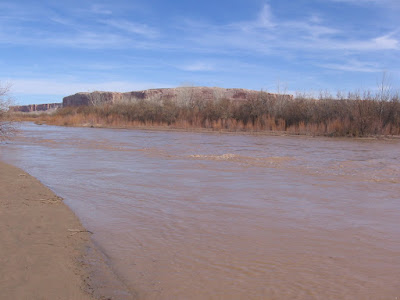The River Panel Trail is a 6 or 3 mile round trip into lower Butler Wash to the junction with the San Juan River. On the bluffs just east and upriver from the junction is a large petroglyph panel. The starting point is 0.2 miles south down the road that leads to the Bluff, Utah airport, five miles west of the town of Bluff on Highway 163 in southeast Utah.
I hiked the 6 mile version across the level desert area with spring wildflowers, but vehicles with 4WD or high clearance can follow the dirt road about 1.5 miles to the canyon rim and start there. The road has a few sandy spots and there is a confusing rocky area near the beginning.
From the rim, the trail descends toward the wash bottom over some spots where the old trail construction with bricklike stones is obvious. There is a large alcove visible on the opposite side of the canyon. I looked at it from several angles with binoculars but couldn’t see anything that made it clear that it was a ruins site. It looks like there is a side trail leading into it.
The trail winds in and out of the wash bottom. There was some flowing water in mid May and the bottom was thick with Tamarisks, Russian Olives, Willows, and a few Cottonwood trees. The Fort Bluff Historic Site information mentions that the early pioneer cabins were constructed using the abundant Cottonwood trees.
It now looks like the Cottonwoods have been pushed aside by the invasive Tamarisks and Olives. There were a lot of cactus flowers in bloom. I saw some Single Leaf Ash trees higher on the canyon sides. About 10 minutes before the junction with the San Juan River there is an alcove with a small ruins site on the west side.
The petroglyph panel faces the San Juan River just east of the river junction. Most visitors will probably arrive via the popular rafting trips that start in nearby Bluff at the Sand Island boat launch. Sand Island also has a large petroglyph panel and the large Butler Wash Panel is only a few hundred yards downstream from the River Panel. This area is very rich in rock art sites.
There are several hundred images to view. Many are at eye level and some are higher in places where you wonder how they were able to work on them.
Some of the higher level images include broad shouldered figures similar to the ones that stand out at the nearby Butler Wash Panel. There are four grooves that look like stone sharpeners mixed in with the images.
On the return hike I noticed a second small petroglyph panel on the west side of Butler Wash just before the canyon junction with the San Juan River. There is a side trail leading up. This side trail is more noticeable on the return hike.
Petroglyphs and Pictographs of Utah

















 The San Juan River flows out of the San Juan Mountains in southwest Colorado and flows through the desert areas of the Four Corners area flowing west to meet with the waters of the Colorado River in Lake Powell.
The San Juan River flows out of the San Juan Mountains in southwest Colorado and flows through the desert areas of the Four Corners area flowing west to meet with the waters of the Colorado River in Lake Powell.






